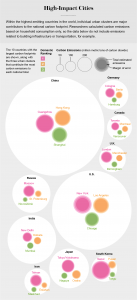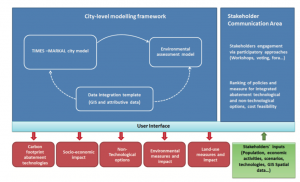Tess Giacobbo
Cities already consume 80% of energy supplies and produce 75% of all carbon emissions. In fact, most environmental challenges stem from cities and our resource intensive urban lifestyles. But at the same time, cities are hotspots for innovation and attract businesses and projects, thus they have the potential to implement transformative solutions for a sustainable future. [1]

Figure a): critical impact of cities on carbon emissions (zoom in for a better picture quality!)
What makes a sustainable city?
Sustainable cities are a compact lively settlement, where little waste is produced, and little land and energy is used. We see hints of sustainable aspects of cities in solar, wind technologies, recycling systems, environmentally friendly public transport systems or the promotion of self- sustained food resources through urban gardening. In short, such a city uses sustainable resources and uses the resources it has efficiently. [2]
Easier said than done: Barriers and challenges
More than half of today’s population in the developing world and 86% of the population in the developed world will reside in urban areas by 2050. This rapid urbanization has negative consequences; Socio-economic inequalities and urban ecosystem degradation become ever-present. Efforts to counter those challenges are seen throughout the world, however often these approaches struggle to address complicated, interconnected, wicked problems, and lead to disorganized, and sometimes counterproductive investments or policy implementation. [3]
In Hungary for example, the lack of regulation and the absence of an integrated plan had taken a severe toll on the newly installed public transport systems in such a way that cars increased again in urban areas. An other example is the tax deduction for commuting costs in some European countries, which subsidises workers who live far away from the place of work without constraints. [7] In fact, the deficiency of big-picture (holistic) perspectives are the biggest barriers to the sustainable urban development. [3]
How can cities address climate change by meeting these challenges?
To keep up with the rapid urbanization we need to accelerate the transition to more sustainable cities. Key actions are financial support and the bridging of disciplines. Moreover, urban energy challenges should not only be operated by workers with high technical skills, but should be addressed by all stakeholders. The bridging of sectors can make up for the lack of knowhow, knowledge or capital and can facilitate the transition into post-fossil society and towards a circular economy.[3]
There are multiple existing tools that can play an important role in bridging the gap between private and public sectors. One example is the joined software platform “SureCity”. [3] Surecity promotes a low-carbon economy and sustainable energy systems. It combines scientific bottom-up models and city planning skills to make holistic mid-to-long term (2030/2050) plans for cities in which they focus on Commercial, Municipal, Residential, Transport, Industry and Public sectors. [4]
How does SureCity work?
The underlying Project of “SureCity” was the creation of an energy model, whose results can visualize a city’s energy consumption, energy production and energy imports in charts, tables, maps and reports. They show the present energy distributions as well as predictions for how these consumption patterns will develop in the future. Indicators of energy consumption (e.g air pollutant emissions, greenhouse gasses, land use, water use and energy efficiency) as well as specific sectors (e.g Waste, Water, Waste-water and Transport sectors) are assessed and analysed in detail.
Different access rights make the platform available to everyone. Local authorities, companies, political leaders, as well as citizens can utilize it. Because the platform is also used by non-technical people, cities can overcome the aforementioned gaps to achieve their sustainability targets. Municipalities benefit from the platform because they can better allocate their resources. Citizens can profit as they get to see how energy is used in their city, how the municipality plans to improve energy strategies and how the sustainability goals of the city will be achieved. Finally, sustainable companies benefit because they can see where the areas of growth are. For instance, a company that sells heat pumps can see where there will be a large market in the future. This helps them to meet the need of this particular city. [5]
The model and the platform are being tested in three cities: Malmö, Sweden; Judenburg, Austria; and Almada, Portugal. Those specific cities were chosen because they represent contrasting climates and because they are all different sizes. These factors generalize the model so it can be applicable to all European cities. Impacts of this project are hoped to see in the upgrading of efficiency of materials, energy, water, food and in a fast renewable energy transition. [6]

Figure b): A graphic representation of the software platform “SureCity”
Conclusion
Amongst all other urban issues, managing urban environmental problems is especially challenging. A combination of top down and bottom up approaches is necessary. The efficient use of resources can shift our economy to a low carbon one, provided the city planning is reshaped and developed on a holistic level to keep up with the growing urbanization. Projects like “SureCity” increase the attractiveness and the sustainability of a city, so new business opportunities emerge. Platforms like this involve local governments and engage city actors as well as urban stakeholders. Therefore they make it possible for everyone to be part of a holistic solution and achieve a collaborative and responsive approach to sustainability development.
For more information about the SureCity Plattform please visit Reference (5).
References
1) https://www.c40.org/why_cities [29. April. 2020]
2) Ecocity Berkeley: Building Cities for a better Future by Richard Register (1943)
accessed from: https://books.google.ch/books?id=QYE-Q8MAF3MC&printsec=frontcover&hl=de#v=onepage&q&f=false
3) Geng Y., Fujita T., Bleischwitz R., Chiu A., Sarkis J.,(2019). Accelerating the transition to equitable, sustainable and livable cities: Toward post-fossil carbon societies, Journal of Cleaner Production
accessed from: https://www.sciencedirect.com/journal/journal-of-cleaner-production/vol/114/suppl/C
4) Paskaleva K., Evans J, Martin C., Linjordet T., Yang D. and Karvonen A. (2017). Data Governance in the Sustainable Smart City, Journal of Cleaner Production
accessed from: https://www.researchgate.net/publication/321093846_Data_Governance_in_the_Sustainable_Smart_City
5) Garcia N., Simoes S., Dias L., Sandgrec A., Sunaa D., Krook-Riekkola A., (2019), Sustainable and Resource Efficient Cities platform – SureCity holistic simulation and optimization for smart cities, Journal of Cleaner Production
accessed from: https://www.sciencedirect.com/science/article/pii/S0959652619300812
6) Interview with Nicolas Pardo by Choudhury S.
accessed from [29. April. 2020]: https://jpi-urbaneurope.eu/news/seeing-the-big-picture-nicolas-pardo/
7) European Conference of Ministers of Transport, (2002), Implementing Sustainable Urban Travel Policies Final Report: Final Report
accessed from: https://books.google.ch/books?id=N3dJ4EPSzAAC&pg=PA34&lpg=PA34&dq=counterproductive+policy+implementation+sustainability&source=bl&ots=9tevE_GcAo&sig=ACfU3U3vbZYUQaaAgeP2NIeeCzxB-s8ykw&hl=en&sa=X&ved=2ahUKEwjcuJWyv5DpAhWjuXEKHfNMASUQ6AEwAXoECAkQAQ#v=onepage&q=counterproductive%20policy%20implementation%20sustainability&f=false
Figures and Images:
a) “Carbon Footprints of 13,000 Cities,” by Daniel Moran et al., in Environmental Research Letters; May 23, 2018, accessed from: https://www.scientificamerican.com/article/heres-how-much-cities-contribute-to-the-worlds-carbon-footprint/#
b) SURECITY Poster for JPI Urban Europe, Available under: http://surecityproject.eu/?q=file/24
Media Attributions
- city_carbonFootprints_graphic_d[1]
- A graphic representation of the software platform “surecity”